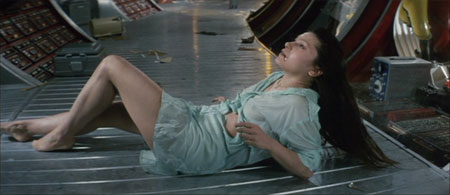Category: Cinema
Reviews of movies Adam has seen or films he has worked on.
A part of this viewing list: Criterion Collection Spine #164: Andrei Tarkovsky’s Solaris.

My Dostoevsky professor once said that Russians are more Oriental than Occidental in temperament, and the contemplative pacing and constant importance of the unimportant throughout Tarkovsky’s Solaris seems to support this assertion fairly well. For those used to Stanislaw Lem’s whimsical cybernetic science fiction, Solaris is more reminiscent of Philip K. Dick, especially with its psychological bent and hallucinogenic atmosphere. These particular aspects give the work and the film both significant staying power; the fiction is phenomenological instead of technological. Eastern Europeans and Asiatics always seem to pull off pensive madness with much more believability than less thoughtful cultures. So Kris, Kelvin can stagger around Solaris Station in naught but his boxers, eyes inward, but when he begins to talk about conscience and consciousness and communication, his outward disorder is merely the sign of a complete internal focus on more important problems.

Kelvin becomes a reflection of Solaris Station, an utter ruin itself; both ignorant to the means and effects of the Solaris Ocean which they are studying. Communication seems to be the theme of this film. Communication with the self as manifested by the appearance of Hari, Kelvin’s long-deceased wife, the planet’s attempt at communication by proxy through the manifestation of Hari, tête-a-tête communication between the scientists and the scientists attempts to communicate with the planet via radiation. On a meta-level we also have Tarkovsky’s attempt to communicate the difficulties of these processes to his viewers. In the end it becomes easier to toss the dice and hope that explanation through evocation and imagery will suffice.

Kelvin seems admirably suited to his job as consultant for the continuation of the Solaris project. He is not so much objective as completely receptive and instead of sitting in indifference, he explores in acceptance. Because of this, he becomes, unwillingly, the first person to successfully communicate with the sentient ocean. After this occurs, the hallucinations cease, but the reappearance of Hari has exhumed his old skeletons, and his is disquieted. At this point, Tarkovsky’s subtle mastery finally reveals itself, the small peaceful natural clues we’ve received throughout the film, flowing water, swaying plants, swirling vistas and obscurant clouds become visual representations of Kelvin’s private thought processes, and the Solaris Ocean offers him full communion with them. A form of communication that we all only wish for.

• Criterion Essay by Philip Lopate.
• Andrei Tarkovsky on Solaris.
• Senses of Cinema article by the Strictly Film School guy.
• Movie Martyr review with stills.
• Official site of Stanislaw Lem.
• Exhaustive site about the film and the book.
• Roger Ebert Review.
• YouTube Clips: 1, 2, 3, 4.